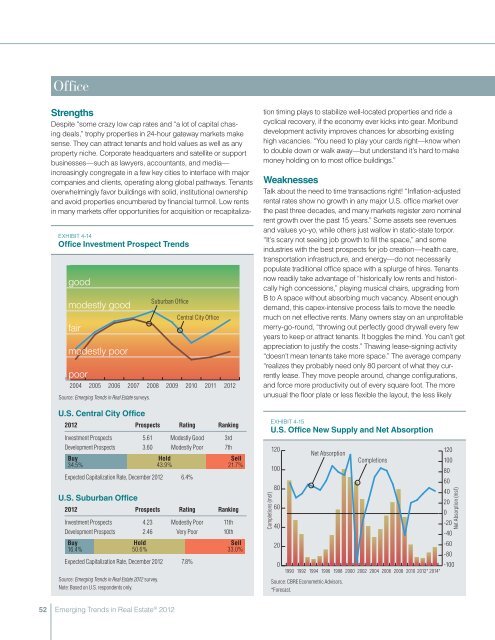Emerging Trends in Real Estate 2012 - Urban Land Institute
Emerging Trends in Real Estate 2012 - Urban Land Institute
Emerging Trends in Real Estate 2012 - Urban Land Institute
You also want an ePaper? Increase the reach of your titles
YUMPU automatically turns print PDFs into web optimized ePapers that Google loves.
Office<br />
ExHIBIT 4-14<br />
Office Investment Prospect <strong>Trends</strong><br />
good<br />
modestly good<br />
fair<br />
modestly poor<br />
poor<br />
2004<br />
2005<br />
2006<br />
2007<br />
Source: <strong>Emerg<strong>in</strong>g</strong> <strong>Trends</strong> <strong>in</strong> <strong>Real</strong> <strong>Estate</strong> surveys.<br />
Suburban Office<br />
2008<br />
2009<br />
Central City Office<br />
2010<br />
2011<br />
<strong>2012</strong><br />
Strengths<br />
Despite “some crazy low cap rates and “a lot of capital chas<strong>in</strong>g<br />
deals,” trophy properties <strong>in</strong> 24-hour gateway markets make<br />
sense. They can attract tenants and hold values as well as any<br />
property niche. Corporate headquarters and satellite or support<br />
bus<strong>in</strong>esses—such as lawyers, accountants, and media—<br />
<strong>in</strong>creas<strong>in</strong>gly congregate <strong>in</strong> a few key cities to <strong>in</strong>terface with major<br />
companies and clients, operat<strong>in</strong>g along global pathways. Tenants<br />
overwhelm<strong>in</strong>gly favor build<strong>in</strong>gs with solid, <strong>in</strong>stitutional ownership<br />
and avoid properties encumbered by f<strong>in</strong>ancial turmoil. Low rents<br />
<strong>in</strong> many markets offer opportunities for acquisition or recapitalization<br />
tim<strong>in</strong>g plays to stabilize well-located properties and ride a<br />
cyclical recovery, if the economy ever kicks <strong>in</strong>to gear. Moribund<br />
development activity improves chances for absorb<strong>in</strong>g exist<strong>in</strong>g<br />
high vacancies. “You need to play your cards right—know when<br />
to double down or walk away—but understand it’s hard to make<br />
money hold<strong>in</strong>g on to most office build<strong>in</strong>gs.”<br />
Weaknesses<br />
Talk about the need to time transactions right! “Inflation-adjusted<br />
rental rates show no growth <strong>in</strong> any major U.S. office market over<br />
the past three decades, and many markets register zero nom<strong>in</strong>al<br />
rent growth over the past 15 years.” Some assets see revenues<br />
and values yo-yo, while others just wallow <strong>in</strong> static-state torpor.<br />
“It’s scary not see<strong>in</strong>g job growth to fill the space,” and some<br />
<strong>in</strong>dustries with the best prospects for job creation—health care,<br />
transportation <strong>in</strong>frastructure, and energy—do not necessarily<br />
populate traditional office space with a splurge of hires. Tenants<br />
now readily take advantage of “historically low rents and historically<br />
high concessions,” play<strong>in</strong>g musical chairs, upgrad<strong>in</strong>g from<br />
B to A space without absorb<strong>in</strong>g much vacancy. Absent enough<br />
demand, this capex-<strong>in</strong>tensive process fails to move the needle<br />
much on net effective rents. Many owners stay on an unprofitable<br />
merry-go-round, “throw<strong>in</strong>g out perfectly good drywall every few<br />
years to keep or attract tenants. It boggles the m<strong>in</strong>d. You can’t get<br />
appreciation to justify the costs.” Thaw<strong>in</strong>g lease-sign<strong>in</strong>g activity<br />
“doesn’t mean tenants take more space.” The average company<br />
“realizes they probably need only 80 percent of what they currently<br />
lease. They move people around, change configurations,<br />
and force more productivity out of every square foot. The more<br />
unusual the floor plate or less flexible the layout, the less likely<br />
U.S. Central City Office<br />
<strong>2012</strong> Prospects Rat<strong>in</strong>g Rank<strong>in</strong>g<br />
Investment Prospects 5.61 Modestly Good 3rd<br />
Development Prospects 3.60 Modestly Poor 7th<br />
Buy<br />
34.5%<br />
Source: <strong>Emerg<strong>in</strong>g</strong> <strong>Trends</strong> <strong>in</strong> <strong>Real</strong> <strong>Estate</strong> <strong>2012</strong> survey.<br />
Note: Based on U.S. respondents only.<br />
Hold<br />
43.9%<br />
Expected Capitalization Rate, December <strong>2012</strong> 6.4%<br />
U.S. Suburban Office<br />
Sell<br />
21.7%<br />
<strong>2012</strong> Prospects Rat<strong>in</strong>g Rank<strong>in</strong>g<br />
Investment Prospects 4.23 Modestly Poor 11th<br />
Development Prospects 2.46 Very Poor 10th<br />
Buy<br />
16.4%<br />
Hold<br />
50.6%<br />
Expected Capitalization Rate, December <strong>2012</strong> 7.8%<br />
Sell<br />
33.0%<br />
Completions (msf)<br />
ExHIBIT 4-15<br />
U.S. Office New Supply and Net Absorption<br />
120<br />
100<br />
80<br />
60<br />
40<br />
20<br />
0<br />
Net Absorption<br />
1990 1992 1994 1996 1998 2000 2002 2004 2006 2008 2010 <strong>2012</strong>* 2014*<br />
Source: CBRE Econometric Advisors.<br />
*Forecast.<br />
Completions<br />
120<br />
100<br />
80<br />
60<br />
40<br />
20<br />
0<br />
-20<br />
-40<br />
Net Absorption (msf)<br />
-60<br />
-80<br />
-100<br />
52 <strong>Emerg<strong>in</strong>g</strong> <strong>Trends</strong> <strong>in</strong> <strong>Real</strong> <strong>Estate</strong> ® <strong>2012</strong>




